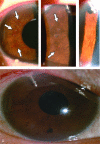Surgical treatment of neovascular glaucoma with Ex-PRESS glaucoma shunt: Case report
- PMID: 28858093
- PMCID: PMC5585487
- DOI: 10.1097/MD.0000000000007845
Surgical treatment of neovascular glaucoma with Ex-PRESS glaucoma shunt: Case report
Abstract
Rationale: Neovascular glaucoma (NVG) is one of the most aggressive types of glaucoma, and its abnormal fibrovascular tissue growth on the iris and trabecular meshwork may create difficulties to control the intraocular pressure (IOP) and perform the operation such as trabeculectomy.
Patient concerns: Ex-PRESS glaucoma shunt has been introduced to serve as one alternative operation for glaucoma, and is thought to have the potential advantage of being less traumatic than traditional trabeculectomy. The purpose of our study is to evaluate the efficacy and safety of primary Ex-PRESS implantation in eyes with NVG.
Diagnoses and interventions: This was a retrospective study of four patients with NVG in whom primary Ex-PRESS implantation was performed between January 2012 and October 2016.
Outcomes: After a mean follow-up of 20.8 ± 8.9 months (range, 15-34 months), three of four NVG patients (75.0%) receiving primary Ex-PRESS implantation had postoperative IOP under 21 mmHg without any antiglaucoma medication control at the last follow-up, but shunt reposition had been performed due to failed blebs or recurrent NVG. Besides, the best corrected visual acuity at the last follow-up was stabilized or improved in three of four NVG patients (75.0%), accompanied with the regression of iris neovascularization. Only one patient had self-resolved postoperative hyphema; otherwise, there were no other perioperative complications.
Lessons: Primary Ex-PRESS implantation might constitute a safe and alternative treatment for patients with NVG. In spite of the possible reoperations, the final outcomes were still shown effective after shunt reposition.
Conflict of interest statement
The authors have no funding and conflicts of interest to disclose.
Figures





Similar articles
-
Pars plana insertion of glaucoma shunt in eyes with refractory neovascular glaucoma: Case report.Medicine (Baltimore). 2018 Jun;97(23):e10977. doi: 10.1097/MD.0000000000010977. Medicine (Baltimore). 2018. PMID: 29879052 Free PMC article.
-
Efficacy and safety of Ex-PRESS® mini shunt surgery versus trabeculectomy for neovascular glaucoma: a retrospective comparative study.BMC Ophthalmol. 2019 Mar 12;19(1):75. doi: 10.1186/s12886-019-1083-4. BMC Ophthalmol. 2019. PMID: 30866871 Free PMC article.
-
A prospective comparative study on neovascular glaucoma and non-neovascular refractory glaucoma following Ahmed glaucoma valve implantation.Chin Med J (Engl). 2014;127(8):1417-22. Chin Med J (Engl). 2014. PMID: 24762581
-
Standard Trabeculectomy and Ex-PRESS Miniature Glaucoma Shunt: A Comparative Study and Literature Review.J Glaucoma. 2015 Aug;24(6):410-6. doi: 10.1097/IJG.0000000000000047. J Glaucoma. 2015. PMID: 24633088 Free PMC article. Review.
-
Early Postoperative Results and Complications of using the EX-PRESS Shunt in uncontrolled Uveitic Glaucoma: A Case Series of Preliminary Results.J Curr Glaucoma Pract. 2014 Jan-Apr;8(1):20-4. doi: 10.5005/jp-journals-10008-1156. Epub 2014 Jan 16. J Curr Glaucoma Pract. 2014. PMID: 26997803 Free PMC article. Review.
Cited by
-
Changes in the Density of Corneal Endothelial Cells in Elderly Diabetic Patients After Combined Phacovitrectomy and Ex-PRESS Glaucoma Implants.Curr Pharm Biotechnol. 2019;20(12):1037-1043. doi: 10.2174/1389201020666190808154341. Curr Pharm Biotechnol. 2019. PMID: 31393242 Free PMC article.
-
A Review of Neovascular Glaucoma: Etiology, Pathogenesis, Diagnosis, and Treatment.Medicina (Kaunas). 2022 Dec 18;58(12):1870. doi: 10.3390/medicina58121870. Medicina (Kaunas). 2022. PMID: 36557072 Free PMC article. Review.
-
Pars plana insertion of glaucoma shunt in eyes with refractory neovascular glaucoma: Case report.Medicine (Baltimore). 2018 Jun;97(23):e10977. doi: 10.1097/MD.0000000000010977. Medicine (Baltimore). 2018. PMID: 29879052 Free PMC article.
-
Comparison between the Express Implant and Transscleral Diode Laser in Neovascular Glaucoma.J Ophthalmol. 2020 May 17;2020:3781249. doi: 10.1155/2020/3781249. eCollection 2020. J Ophthalmol. 2020. PMID: 32509340 Free PMC article.
References
-
- Tham YC, Li X, Wong TY, et al. Global prevalence of glaucoma and projections of glaucoma burden through 2040: a systematic review and meta-analysis. Ophthalmology 2014;121:2081–90. - PubMed
-
- Allingham RRSM. Shields’ Textbook of Glaucoma. Philadelphia, PA: Ovid Technologies Inc; 2011.
-
- Sivak-Callcott JA, O’Day DM, Gass JD, et al. Evidence-based recommendations for the diagnosis and treatment of neovascular glaucoma. Ophthalmology 2001;108:1767–76. - PubMed
Publication types
MeSH terms
LinkOut - more resources
Full Text Sources
Other Literature Sources

